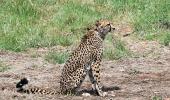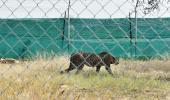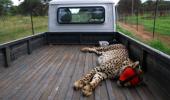'The space required for wild cheetah populations to thrive was grossly under-estimated.'
'Cheetahs, because of their social system and ecologically fragile nature, live at only 1 cheetah per 100 sq kms even in the best habitats of Africa.'

Bringing eight cheetahs from Namibia under Project Cheetah was highly publicised.
It was the prime minister who opened the crates and released the first two cheetahs into the Kuno National Park in Madhya Pradesh.
The prime minister described Project Cheetah as India's 'endeavour towards environment and wildlife conservation' and painted a portrait of how this project will lead to the establishment of free-ranging wild cheetah population.
Almost a year later, out of the 20 cheetahs that arrived in India, six of them have died.
What went wrong ?
Dr Ullas Karanth, a wildlife ecologist who has conducted long-term research on the ecology of tigers, other predators and their prey in India and other parts of Asia, analyses Project Cheetah.
Dr Karanth is the Emeritus Director of the Centre for Wildlife Studies, which he founded in 1984.
"If you are thinking of a reasonable population of cheetahs surviving on wild prey and increasing its numbers gradually, you need 10,000-15,000 sq kms of habitat space to start off. Kuno National Park is 800 sq kms," Dr Karanth explains to Rediff.com's Shobha Warrier in the first of a two-part interview.
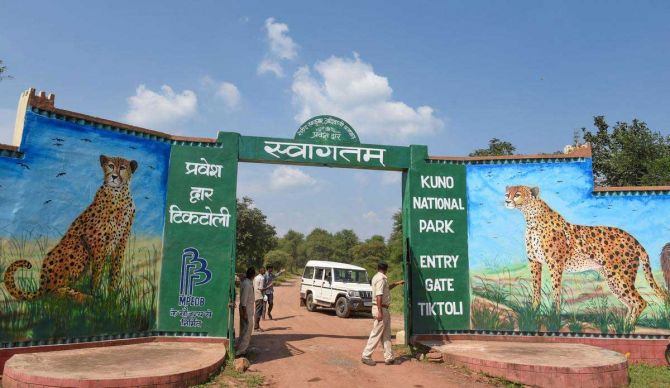
Project Cheetah was launched with a lot of fanfare. When six of the 20 cheetahs that had come from Africa died, many people started saying that the project was ill-conceived. Do you feel no proper study or thought went behind the relocation of them?
First, none of the media reports mention that the project was planned in 2010 by the UPA government under Dr Manmohan Singh.
The idea, planning and key scientific modelling were all done by the same scientists of WII (Wildlife Institute of India) and forest managers of the NTCA (National Tiger Conservation Authority) with active encouragement from minister Jairam Ramesh.
The problem was, there was an obstacle in the Supreme Court and there was not much money. All this happened before the NDA government came to power.
What the present government did was, they simply took the same plan and pumped in a massive funding of over Rs 100 crore (Rs 1 billion) and rushed into implementation without any re-examination of the flawed project proposal.
The fanfare and publicity made people think it is a new project, and this aspect needs to be made clear, which no one seems to bother about.
Ironically, the same government scientists and officials who hatched the plan were entrusted with its implementation.
So clearly the failure is theirs as much as of the political forces who empowered them.
Now, to the question whether the Cheetah plan was well thought through. I don't think it was.
The plan is inadequate and has fundamental scientific deficiencies.
For example, the space required for wild cheetah populations to thrive was grossly under-estimated.
Cheetahs live at very low population densities unlike leopards and tigers which attain population densities of 6-7 animals per 100 sq.kms or even higher.
Cheetahs, because of their social system and ecologically fragile nature, live at only 1 cheetah per 100 square kilometres even in the best habitats of Africa.
Where there is enough prey to support 10 or more tigers or leopards, you can have only one cheetah. This is an inherent characteristic of the species, which cannot be ignored.
Next issue is, the survival rates of cheetahs are naturally very low.
When there are other predators like lions, leopards, tigers, etc., it comes down even further.
Of all the cheetahs born, only 5% grow to adult stage and breed in good habitats in Africa.
In an introduced population, this survival rate is even likely to be lower.
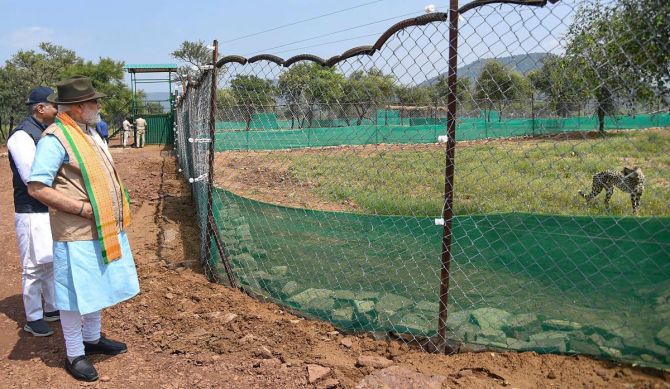
What could be the reason for their survival rate being so low?
The reason is, it is a fragile species. There is very high cub mortality.
As adults, cheetahs find it difficult to obtain enough prey as they have to dodge other predators constantly.
They are very often harassed and even killed by other bigger predators like lions, leopards in Africa, and tigers and leopards in India.
Because of this reason, they require very large spaces with high densities of wild prey animals and relatively low densities of dominant predators.
So, if you are thinking of a reasonable population of cheetahs surviving on wild prey and increasing its numbers gradually, you need 10,000-15,000 sq kms of habitat space to start off.
Kuno National Park is 800 sq kms. Even if you take the surrounding areas of highly disturbed and fragmented forest patches, there is not more than 3,000 sq kms.
In Africa, the human population density is very low, and you don't have hundreds of feral dogs roaming in rural landscapes like in India.
Plus, we have a very high density of leopards and a few tigers at the Kuno National Park.
For all these reasons, the Kuno project was doomed to fail as I had said a long time ago.
In 2010, conservationist Valmik Thapar and I opposed this project when it was proposed by Mr Jairam Ramesh. But the NTCA and WII ignored our criticism, and went ahead with the project.
They have to take the responsibility, not just their political bosses.
Ironically, the same set of people are calling the shots even 13 years later.
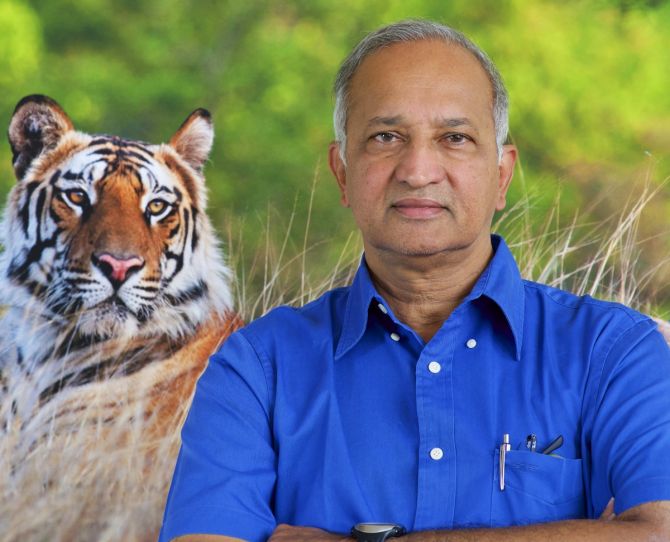
Is it not unfair to the cheetahs to put them in such a small area when they need more open space?
I would say it is unscientific. I am not a judge to say whether it is fair or not.
It is not good use of public funds. The Kuno project is doomed to fail.
Even now, best cheetah ecologists from Africa like Gus Mills, Sarah Durant, Bettina Watcher have cautioned us about the same issues and suggested that what India is doing is not correct.
The project needs a different approach.
Yes, they have some other experts from Africa as advisors, but these are by and large managers of captive and semi-captive cheetah populations.
They had no clue about how our society and government function, and are now complaining.
Unfortunately, both the UPA and the NDA overnments were very poorly advised by NTCA bureaucrats and WII government scientists for 13 long years. There is no accountability at all.
- Part II of the Interview: 'Project Cheetah is a failure'
Feature Presentation: Rajesh Alva/Rediff.com

